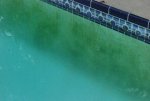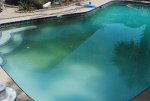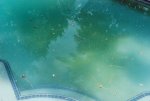Test Results: (pretty consistent via 3 different pool stores)
FC: 0
TC: 0
PH: 7.5
TA: 80
Calcium: 190
CYA: 0-10ppm (I got 2 different results)
TDS: 1000
Cop/Iro: 0
Phosph: 500
I know the numbers are kind of off but thats a headache in itself, but I'm clear now thanks to this site.
I have been going through (that hot/fire place) and back with this pool. I've invested 1000$ into grids, manifold, multi-port, impeller, diffuser, a tech, and WAY too many chemicals, and very little results. Originally I was getting massive amounts of DE back into the pool, I didnt have all that money up front so the pool sat for 3 months. End result was thick green swamp with tadpoles.
After fixing the pump/filter I got it so it doesnt send DE back in and it works good. The "chain" store sold me a bunch of yellow treat, some all-in-one 3 month algae killer, shock, tabs, and a long list of "add this" "add that" junk. Within the past 2 weeks I've gone from the green soup to cloudy blue with a tinge of green and green stains on all walls and big blotches on the floor. I can see the shallow end floor through the cloud, and I can see about 3-4 feet down in the deep end, and all the walls. When I backwash, it's thick/milky looking with a light tinge of green.
I realize, after reading this site, the next step is to bring up the CYA and then begin the course of "Turning Your Green Swamp Back into a Sparking Oasis" (the shocking, testing, backwashing, etc.)... Which on a side note, NONE of the 3 pools stores I went to told me "the reason you're losing suction after 30 mins of filtering and needing to backwash is the result of a heavily dirty pool"... All of them wanted me to pay them to come out to "diagnose" my pool problem. This site, and that article, confirmed my suspicion that it was just heavily dirty.
Anyways, I am at a crossroad and I need some opinions. Right now I am torn between draining and acid washing and starting from scratch, or going the route of "Turning Your Green Swamp Back into a Sparking Oasis", chemically. Normally that would be an obvious decision, however, right now all the walls of my pool and two huge blotches on the floor are stained GREEN (algae I assume), at least I believe they are stained. I've tried brushing, scrubbing, and vacuuming and nothing is working. Will those stains go away when I get the water clean? Is there a special chemical or cleaner for those stains or should I start from scratch? I would hate to drop all that time and money into cleaning the pool only to have the stains remain (they're pretty ugly).
Also, I just discovered through this site about using bleach (I'm still a little confused, but at least my mind is open). Would that be a cheaper/better/similar way to shock the pool during the cleaning phase? Right now I'm using powdered shock (don't know if that info is needed). But I've read the BBB for Beginners post and I'm 99% sure that I want to go that route (going to start pricing bleach, and comparing tomorrow).
I will also attach a pic of the green walls tomorrow (during the sunlight).
Thanks!!
FC: 0
TC: 0
PH: 7.5
TA: 80
Calcium: 190
CYA: 0-10ppm (I got 2 different results)
TDS: 1000
Cop/Iro: 0
Phosph: 500
I know the numbers are kind of off but thats a headache in itself, but I'm clear now thanks to this site.
I have been going through (that hot/fire place) and back with this pool. I've invested 1000$ into grids, manifold, multi-port, impeller, diffuser, a tech, and WAY too many chemicals, and very little results. Originally I was getting massive amounts of DE back into the pool, I didnt have all that money up front so the pool sat for 3 months. End result was thick green swamp with tadpoles.
After fixing the pump/filter I got it so it doesnt send DE back in and it works good. The "chain" store sold me a bunch of yellow treat, some all-in-one 3 month algae killer, shock, tabs, and a long list of "add this" "add that" junk. Within the past 2 weeks I've gone from the green soup to cloudy blue with a tinge of green and green stains on all walls and big blotches on the floor. I can see the shallow end floor through the cloud, and I can see about 3-4 feet down in the deep end, and all the walls. When I backwash, it's thick/milky looking with a light tinge of green.
I realize, after reading this site, the next step is to bring up the CYA and then begin the course of "Turning Your Green Swamp Back into a Sparking Oasis" (the shocking, testing, backwashing, etc.)... Which on a side note, NONE of the 3 pools stores I went to told me "the reason you're losing suction after 30 mins of filtering and needing to backwash is the result of a heavily dirty pool"... All of them wanted me to pay them to come out to "diagnose" my pool problem. This site, and that article, confirmed my suspicion that it was just heavily dirty.
Anyways, I am at a crossroad and I need some opinions. Right now I am torn between draining and acid washing and starting from scratch, or going the route of "Turning Your Green Swamp Back into a Sparking Oasis", chemically. Normally that would be an obvious decision, however, right now all the walls of my pool and two huge blotches on the floor are stained GREEN (algae I assume), at least I believe they are stained. I've tried brushing, scrubbing, and vacuuming and nothing is working. Will those stains go away when I get the water clean? Is there a special chemical or cleaner for those stains or should I start from scratch? I would hate to drop all that time and money into cleaning the pool only to have the stains remain (they're pretty ugly).
Also, I just discovered through this site about using bleach (I'm still a little confused, but at least my mind is open). Would that be a cheaper/better/similar way to shock the pool during the cleaning phase? Right now I'm using powdered shock (don't know if that info is needed). But I've read the BBB for Beginners post and I'm 99% sure that I want to go that route (going to start pricing bleach, and comparing tomorrow).
I will also attach a pic of the green walls tomorrow (during the sunlight).
Thanks!!





